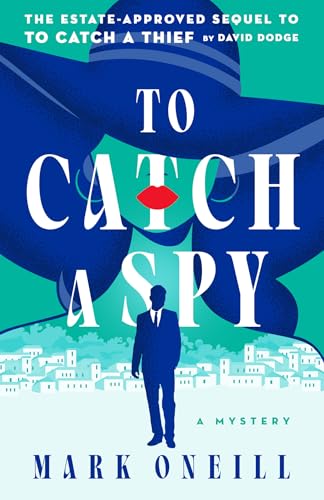
To Catch a Thief, the 1952 novel by American mystery writer David Dodge (1910-1974) tells the story of John Robie, an American expatriate who is trying to live a quiet life in a villa, which he audaciously names Villa des Bijoux (Villa of the Jewels) in the South of France.
Before World War II, Robie had put his acrobatic training to use as a jewel thief operating on the Côte d’Azur and was nicknamed Le Chat (The Cat) by the French press for his gravity-defying ability to soundlessly enter and exit hotel rooms and apartments of his wealthy victims. He worked alone and “was never known to employ violence or carry a weapon more dangerous than a glass cutter.”
Eventually, he was arrested and sentenced to 20 years in a French prison. When the Germans occupied France during the war, they emptied the jails. Robie, along with his cellmates, went into the maquis, the French underground, and fought against the Germans. In exchange for their service to France, the ex-prisoners were extended an unofficial amnesty for their crimes—provided they stay out of trouble.
Now a new thief is at work on the Riviera, using Robie’s exact methods, and the police are convinced that Le Chat is back in business. So, Robie determines to catch the thief himself.
(Extracted from R Brandt. “The Easiest Eighty Thousand Words Ever Put Together”: The Story Behind the Story of David Dodge’s “To Catch a Thief” Used with Permission.)

At first glance this short synopsis suggests a seemingly simple premise for a stage adaptation. Certainly, it is one filled with myriad possibilities, gloriously aided by location, period style, glamour, and a cast of richly drawn characters – most of whom being not who they profess to be – as well as the obvious potential for riveting suspense and action sequences.
But, behind these immediately attractive attributes one starts to glimpse the musical and dramatic possibilities of characters who are propelled to action and thought; not in the act of stealing or attempting the recovery of a dizzying array of stolen jewels, but by the deeply ingrained human desire to find purpose in their individual lives.
This is the heart of To Catch A Thief – The Musical.
New Edition and Book Based On To Catch A Thief

The Library of Congress Crime Classics series features some of the finest American crime writing from the 1860s to the 1960s. Drawn from the Library’s unequalled collections, series editor and mystery expert Leslie S. Klinger has selected scarce and lesser known titles that represent a range of genres, from “cozies” to police procedurals. Priced and formatted for wide readership and classrooms, each volume includes the original text, as well as a contextual introduction, brief biography of the author, notes, recommendations for further reading, and suggested discussion questions. Crime Classics are published by Poisoned Pen Press, an imprint of Sourcebooks, in association with the Library of Congress.
“Le Chat” (“The Cat”), an infamous thief, has come out of retirement and is again liberating expensive jewelry from wealthy tourists on the FreRch Riviera. Or is it a “copycat” who is stealing fortunes?
John Robie thought he had left his larcenous past behind. Once responsible for a string of daring thefts and escapes, he was caught and sent to prison just before the outbreak of World War II. Freed during the German occupation of France, Robie joined the French Resistance and received unofficial amnesty after the war ended. He retired to a simple life in the country where he befriended the local commissaire, Oriol, and tended his gardens. Now it’s 1951, and someone has been at work using his old MO. When the police come to arrest him, Robie escapes to Cannes. There, he reconnects with his former comrade Bellini, who convinces Robie to help catch the copycat.
Disguised as a pudgy, middle-aged American businessman, Robie scouts the local nightclubs and casinos and tries to outthink the new thief. When he meets Francie Stevens, the daughter of a wealthy tourist, she becomes Robie’s unwelcome ally, and together they hatch a dangerous plan to catch the thief at a gala party. With Oriol and the police on his trail, will he escape capture? Will the real thief be caught? And will Robie give up the thief?

Estate approved sequel to the novel To Catch a Thief by David Dodge and 1955 Academy Award-winning film by Alfred Hitchcock
“A worthy sequel to the classic.” — Harlan Coben
It’s been a year since John Robie, notorious Riviera jewel thief, proved his innocence by catching a copycat burglar. And it’s been a year since John has seen Francie Stevens, the adventurous socialite who not only saw through his disguise, but helped him catch the copycat.
Now Francie is returning to the Riviera for its first-ever Fashion Week as a model for a top French designer, and John plans on rekindling their romance. But there’s a problem. While helping a friend, John chases down a mysterious courier, whose ruthless associates now want John dead. To make matters worse, when Francie arrives, she has a boyfriend in tow, and tells John that she wants nothing to do with him.
John has to figure out why he’s a hunted man, and why Francie is acting suspiciously. Digging deeper, he discovers a spy ring with evil intent. As John works unofficially to gather evidence, a question begins to haunt him — could Francie Stevens be a spy? With his enemies closing in, John turns to his cat burglar skills to try to save his life and expose the traitors. To survive, he has to catch the spies before they catch–and kill–a retired thief!
